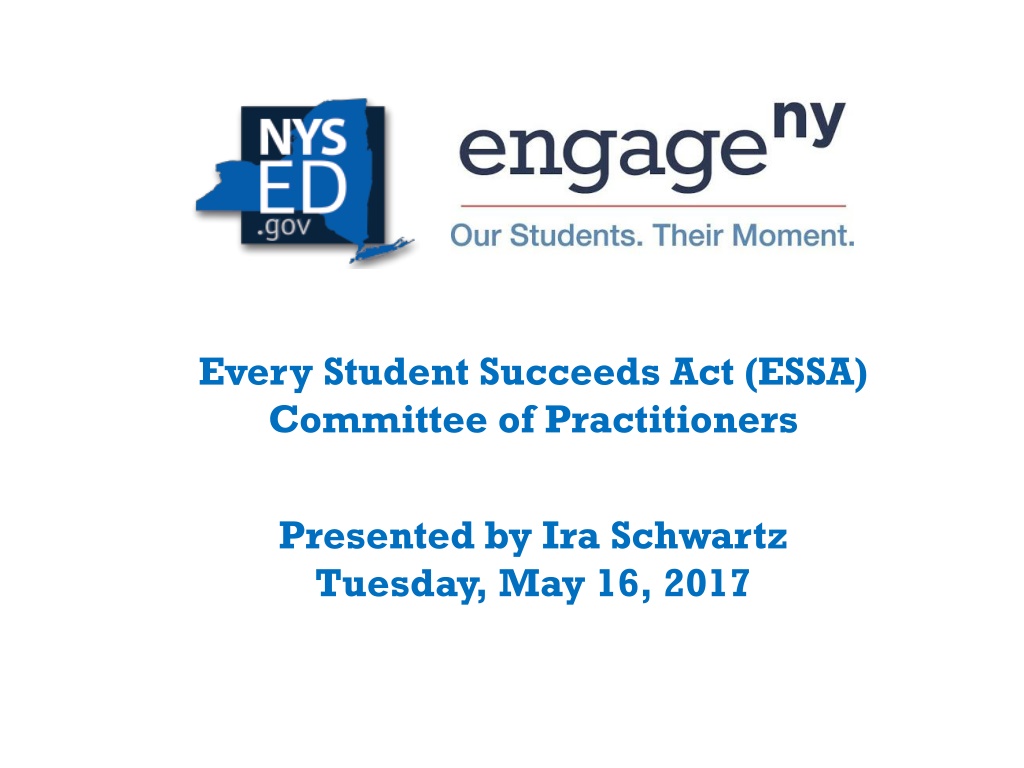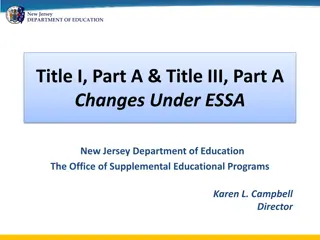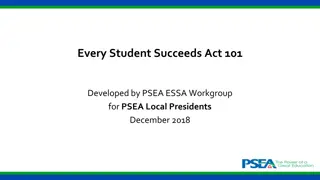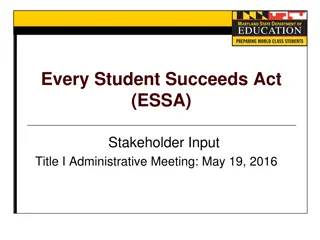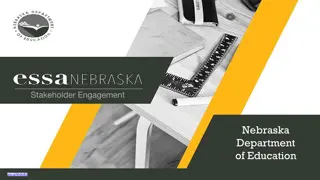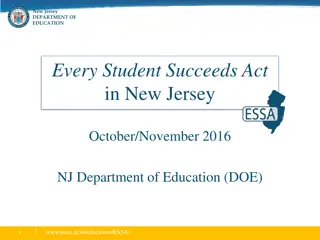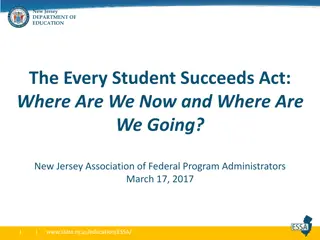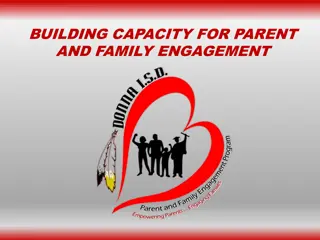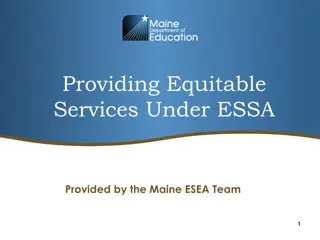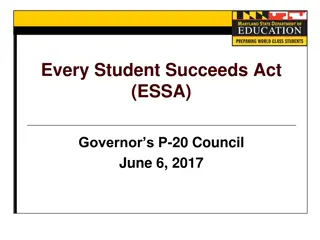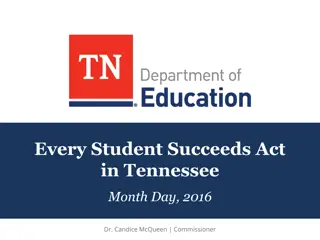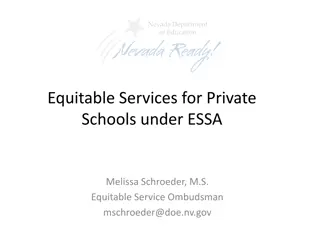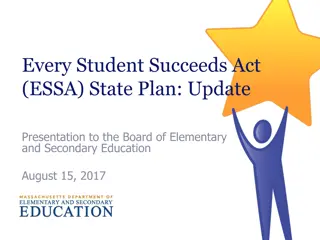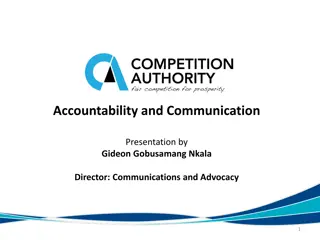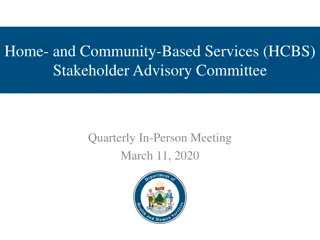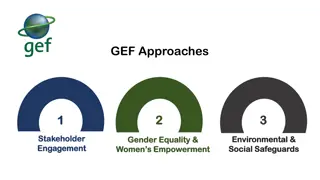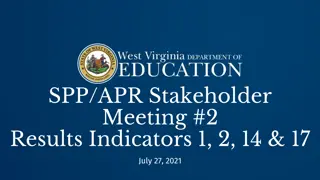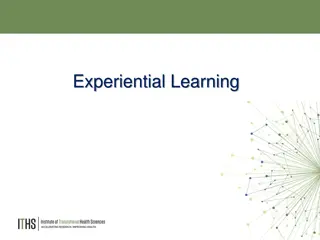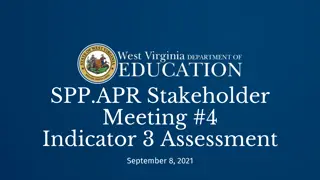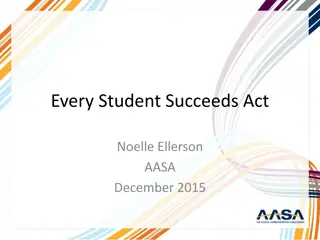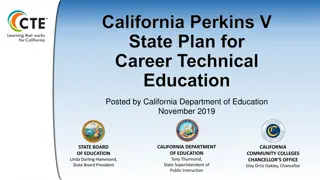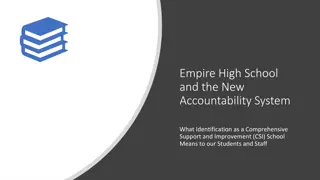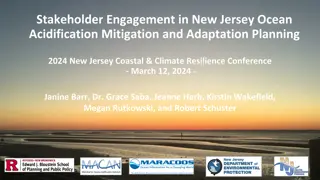Stakeholder Engagement and Accountability under ESSA for New York State's Education Plan
The Every Student Succeeds Act (ESSA) Committee of Practitioners, led by Ira Schwartz, presented New York State's education plan in a comprehensive manner on May 16, 2017. Stakeholder engagement has been crucial, with input gathered from various organizations, parents, educators, and community members through surveys and in-person meetings. The plan emphasizes accountability by measuring school performance through a range of indicators beyond test scores, focusing on academic growth, and prioritizing support for schools that show improvement. The system aims to be transparent, value-driven, and effective in identifying schools in need of assistance.
Uploaded on Nov 22, 2024 | 0 Views
Download Presentation

Please find below an Image/Link to download the presentation.
The content on the website is provided AS IS for your information and personal use only. It may not be sold, licensed, or shared on other websites without obtaining consent from the author. Download presentation by click this link. If you encounter any issues during the download, it is possible that the publisher has removed the file from their server.
E N D
Presentation Transcript
Every Student Succeeds Act (ESSA) Committee of Practitioners Presented by Ira Schwartz Tuesday, May 16, 2017
Questions? Email them to: accountinfo@nysed.gov
New York States Voices, New York State s Plan
Stakeholder Engagement Since the fall of 2016: More than 100 organizations helped to develop the plan through the ESSA Think Tank National experts and advocates advised NYS throughout the process The Title I Committee of Practitioners has provided ideas for the use of ESSA funds 2,400 parents, educators, community members, and other stakeholders have shared feedback on school quality indicators, teacher preparation, school improvement, and accountability system design through an online survey 4,000 people attended more than 120 in-person meetings across the State and in NYS s five largest City School Districts ~250 meeting participants provided further feedback via an online survey after attending in-person meetings Thirteen (13) in-person sessions have been planned for May and June to explain the plan and hear comments NYS established a dedicated e-mail address, ESSAcomments@nysed.gov, to receive public comments NYS has created a narrated webinar explaining the plan 4
What We Heard, Propose, and Want to See
Accountability How Should New York State Measure and Differentiate School Performance? New York State strives for an accountability and support system that supports all students, is transparent, prioritizes the measures that our educators and families value, recognizes schools that improve, and accurately identifies schools that need the most help. 7
Accountability What We Heard: Measure student success on a variety of indicators not just test scores Measure students academic growth over time, not just a single snapshot of performance Collect data, such as class size or students access to coursework, for planning and support, not initially for accountability 8
Accountability What We Propose: Measuring achievement in English and mathematics, plus growth in those subjects, as well as in social studies and science Measuring chronic absenteeism for all schools and indicators of college, career, and civic readiness (e.g., advanced coursework, career-technical training) for high schools Considering other indicators of school quality Awarding partial, full, or extra credit to schools for students success, to provide incentives for schools to improve all students performance 9
Accountability What We Want to See: More schools offering advanced coursework and career readiness opportunities so that students graduate with the highest possible credential Emphasis on moving ALL students performance, not just those close to meeting their academic targets More information about individual schools and districts in the hands of families and the public 10
School Improvement How Should New York State Assist Low- Performing Schools? New York State will develop a system for supporting schools identified for improvement so that the schools that need the most support receive the most attention. 12
School Improvement What We Heard: Allow schools to develop strategies based on their needs, rather than prescribing a one- size-fits-all approach Provide flexibility to the schools that are making improvements, and provide support and interventions to the schools that are not making gains Consider ways to engage parents, not just by offering school choice 13
School Improvement What We Propose: Supporting a needs assessment process that looks at all aspects of schooling, including resource allocation Providing broad supports in the first year of identification, and then focusing support on the schools not making gains in subsequent years Offering parents a voice in how select funding is spent 14
School Improvement What We Want to See: More individualized, evidence-based school improvement plans and more equitable uses of resources Increased likelihood that low-performing schools will improve Increased parent engagement in all schools, especially schools in need of improvement 15
Great Teaching How Should New York State Ensure Equitable Access to Effective Educators? New York State believes that all students, regardless of race, income, background, gender, disability status, primary language, or ZIP code, should have equitable to access to the most effective educators. 17
Great Teaching What We Heard: Offer student teachers and principals more ways to demonstrate their skills in real school and classroom settings Better align needs of districts and schools with teacher and principal preparation programs Support aspiring teachers and aspiring principals throughout their careers, not just at the beginning 18
Great Teaching What We Propose: Reporting and helping districts analyze equity gaps in their schools access to effective educators Considering changes in teacher candidates field experiences and placement Assisting districts with new career ladders or pathways to make the profession more attractive 19
Great Teaching What We Want to See: Greater numbers of effective educators in every school, regardless of size, location, or student population A more diverse and culturally responsive teaching workforce Better-prepared novice teachers with more training in real classrooms More opportunities for experienced educators to grow their expertise 20
Support for All How Will New York State Ensure an Excellent Education for Every Child? New York State believes that the highest levels of learning can occur when students and educators learn and teach in environments that are safe, supportive, and welcoming to all. 22
Support for All What We Heard: Consider the effect of testing on school environments Help schools create more positive school climates Consider English Language Learners /Multilingual Learners (ELL/MLL) starting points when measuring English language proficiency Consider the wide range of individual needs of students with disabilities when measuring performance and designing schoolwide supports 23
Support for All What We Propose: Applying to USDE program to pilot new kinds of assessments, including those that reduce testing time Piloting and then expanding the use of a school climate survey Reinforcing anti-bullying laws Recognizing the unique needs of ELLs/MLLs and differentiating accountability for progress, based on initial language proficiency Reinforcing the principles of Universal Design for Learning (UDL) to promote equal opportunities for students to learn 24
Support for All What We Want to See: More creative and innovative assessments More safe and welcoming school environments for students, teachers, and families More support for ELLs/MLLs to gain language proficiency Higher achievement for migrant youth, homeless youth, students in foster care, and students involved in the juvenile justice system Increased access to the general education curriculum and more opportunities for students with disabilities to achieve their postsecondary goals 25
Questions? Email them to: accountinfo@nysed.gov
What Stays the Same? What Will be Different?
Challenging Academic Standards & Aligned Assessments What Stays the Same? What Will be Different? Requirement that students be annually assessed in Grades 3-8 in English language arts and mathematics New Next Generation English language arts, mathematics, and science learning standards Requirement that students be assessed once in high school in English language arts and mathematics Reduction in length of Next Generation assessments Requirement that students be assessed once in science at the elementary, middle, and high school levels Application for federal innovative assessment pilot 28
School Accountability, Methodologies & Measurements What Stays the Same? What Will be Different? Accountability system that includes English language arts and mathematics assessment results and graduation rates Inclusion of new indicators in the areas of science; social studies; chronic absenteeism; acquisition of English language proficiency by English language learners/Multilingual leaners; and college, career, and civic readiness. Revised Performance Indices that give schools extra credit for students who are advanced. Use of six year graduation cohort results Accountability determinations linked, in part, to subgroup performance in relation to State goals and annual progress Identification of lowest-performing schools, based on the performance of all students as well as the performance of subgroups of students 29
School Accountability, Methodologies & Measurements What Stays the Same? What Will be Different? Identification of low-performing districts Sunset of identification of Local Assistance Plan Schools More rigorous standards for identification of high schools based on graduation rate as required by ESSA Data dashboards to provide more transparent reporting of results, including for indicators that are not part of the accountability and support system Advisory Group to examine different indicators of school quality for accountability Public reporting of school and district performance 30
Supports & Improvement for Schools What Stays the Same? What Will be Different? On-site State field support that focuses on technical assistance and recommendations for improvement, rather than monitoring for compliance On-demand technical assistance during the development of school and district improvement plans Individualized approach to supporting low-performing schools facilitated by NYSED Primary State support given to Comprehensive Support and Improvement Schools; district support given to schools with low-performing subgroups Examination and addressing of resource inequities in low-performing schools Ongoing State support throughout the school improvement process 31
Supports & Improvement for Schools What Stays the Same? What Will be Different? Interventions, such as receivership Incentives for districts to promote diversity and reduce socioeconomic and racial isolation Teacher transfers to low-performing schools limited to teachers rated Highly Effective or Effective Robust technical assistance from the State for low-performing schools Parent voice in some budget decisions in low-performing schools 32
Supporting Excellent Educators What Stays the Same? What Will be Different? Continued Evaluation of Teachers and School Leaders Implementation of new strategies for use of Title IIA funds to support professional development of teachers and school leaders Existing educator and leader certification and licensure systems Partnership with higher education to improve aspiring teachers student teaching and field experience programs Reporting of data on access to effective educators in each district and facilitate analysis in each district to discuss solutions Increased focus on closing gaps of access to effective educators between low- and high-performing schools Convening a Clinical Practice Work Group to examine changes to the current field experience and placement requirements for teachers and school leaders 33
Supporting English Language Learners/Multilingual Learners What Stays the Same? What Will be Different? Comprehensive services for students whose first language is not English Exemption of recently arrived English language learner students from the State s English Language Arts test and inclusion of their scores in their second year of schooling only as a baseline Focus on English Language Learners /Multilingual Learners path to proficiency by holding schools accountable for their progress New method for determining whether students are making adequate annual progress towards proficiency in English Monitoring of districts English Language Learners /Multilingual Learners attainment of English language proficiency 34
Supporting All Students What Stays the Same? What Will be Different? Support to districts in enforcing anti- bullying laws and encouraging safe school climates Communication of policies and programs for students who are homeless, in juvenile-justice facilities, or are migrants Continued training of educators on the Dignity for All Students Act Piloting and eventually using a school climate survey that will be used as part of a school climate index Promotion of equitable access to school library programs Reporting of per-student expenditures and their sources for each school and district Improving access to all programs for students who are homeless, in neglected or delinquent facilities, or are migratory 35
ESSA Public Comments Comments may be submitted in three ways: 1) In person at an ESSA Public Hearing, 2) Via E-mail at: ESSAcomments@nysed.gov or 3) Via US Postal Service to: New York State Education Department, ATTN: Dr. Lisa Long, Office of Accountability, Rm 400, 55 Hanson Place, Brooklyn, New York 11217 36
Additional ESSA Resources All ESSA related materials, including the plan, the summary, the webinar and public hearing dates and locations can be found on the Department s website at: http://www.p12.nysed.gov/accountability/ess a.html. 37
Questions? Email them to: accountinfo@nysed.gov
